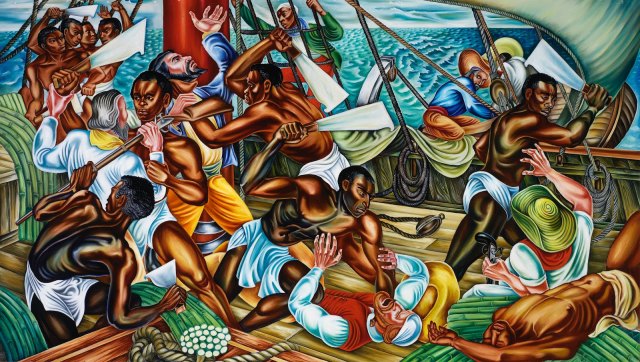
During the eighteenth and nineteenth centuries, slavery was prevalent in America. Many abolitionists, such as freedman Frederick Douglass, spoke out against the use of slavery, gradually shifting the national majority in favor of the abolitionist cause; abolitionists’ influence persisted past the Civil War Era, as evident in modern representations of slavery, such as those by African-American artist Hale Woodruff.
In Narrative of the Life of Frederick Douglass, An American Slave, Frederick Douglass examines how slave masters maintained control of their slaves by granting them a brief vacation from work; this holiday overindulged slaves with the freedom they so desperately desired in order to discreetly present freedom as a cause that is not worth fighting for. Douglass introduces the winter holiday as “time [the slaves] regarded as [their] own, by the grace of [their] masters” (114). On the surface level, this break from work seems to be a voluntary act of kindness from the slaveholders. However, Douglass recognizes that these days off actually functioned as a tool to convince slaves that they are not missing anything because they lack freedom. During the holidays, the masters overindulged slaves with alcohol and leisurely activities, eventually “disgust[ing] the slave[s] with freedom, by allowing [them] to see only the abuse of it” (116). These holidays distorted slaves’ expectations of being free men by exposing them to the polar opposite of slavery—reckless, excessive freedom. By the time the holidays were over, the slaves felt sick of freedom; as a result, their masters would not have to worry about the threat of rebellion. Douglass exposes the slaveholders as ruthless manipulators in order to provide more reasons to rise up against slavery.
The method Douglass describes has striking parallels to Sun Tzu’s theory of war as the art of deception. Sun Tzu states, “The supreme art of war is to subdue the enemy without fighting.” In essence, that is exactly what the slaveholders have done. They set aside this holiday to provide slaves with exactly what they want—freedom—but present it to them in a way that is entirely different from what it actually is. As a result, slaves developed the misguided impression that freedom is somewhat of a burden. In Narrative of the Life of Frederick Douglass, An American Slave, Douglass states:
So, when the holidays ended, we staggered up from the filth of our wallowing, took a long breath, and marched to the field,—feeling upon the whole, rather glad to go, from what our master had deceived us into a belief was freedom, back to the arms of slavery. (116)
The brief period of overindulgence riddled with “filth” functioned exactly as the slaveholders intended: it acted as a buffer that delayed slave revolt. Rather than merely being obligated to return to work, the slaves were somewhat relieved to. Douglass dissected the slaveholders’ method to keeping their slaves under control in order to warn slaves of their masters’ disingenuous intentions.
“The Mutiny on the Amistad” (Fig. 1) by Hale Woodruff depicts a violent slave uprising; this is what slaveholders feared and tried to prevent through tactics such as those outlined by Frederick Douglass. This mural is part of a series that celebrates the abolishment of slavery. It depicts a noteworthy event in the Spanish slave trade: African slaves physically revolt against their captors, who show no signs of resistance. The slaves are portrayed as fearless and strong, fighting for their freedom; in contrast, their captors are seen surrendering or running away, with no true resolve. In addition to implying that slaves are more valiant than their masters, this illustration commemorates the bravery of slaves who recognized the urgency of the abolitionist cause. The mural’s vibrant colors and cartoonish style detract from the violence of the situation and instead romanticize the insurgency. By emphasizing the historical significance of the slave revolt, Woodruff urges slaves to fight against their masters, who—as suggested by this mural—do not have any real power over them. Hale Woodruff’s “The Mutiny on the Amistad” illustrates what can happen when slaves seek justice against their deceptive masters.
Abolitionists were largely responsible for spreading anti-slavery sentiment, encouraging slaves to fight or run away from their masters and the majority of Americans to disapprove of slavery. Their influence was so powerful that it extended beyond the post-Civil War Era, inspiring works of fairly modern artists such as Hale Woodruff.
